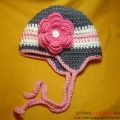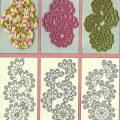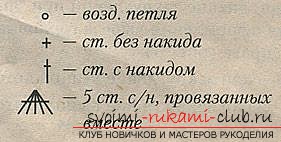
Crochet dresses: master classes with step-by-step instruction, photos and charts
Crochet crocheted lace dressesKnitting crocheted is considered a recognized kind of needlework for handymen. Constantly the number of fans of crocheting increases and this is understandable why. The magnificence of the patterns that are crocheted is incredibly attractive. With the help of a simple device, a hook can create clothes for both adults and children, various openwork napkins, blankets and blankets, curtains and decorations for the kitchen. Update old things, tie a collar, do bulk applications, decorate with a flower and so on. It is not necessary to think that this kind of needlework is available only to professionals. To create beautiful lace dresses with the help of a hook, even a beginner skilled worker can. Increased interest for everyone who already has crochet experience or just gets knitting skills, to the existing opportunity to create a boundless variety of wardrobe items, revealed by this handicraft. Sweaters and jackets, dresses and tunics, scarves and hats, skirts and tops, swimsuits and summer suits - all this you can tie yourself with the help of a hook and thread. Today we suggest you to tie an openwork dress from motifs of 44-46 size. To do this, we need yarn wool 500 g and hook 3 mm. Now we pick up the hook and yarn, and start the entertaining lesson. And at the end you will get an excellent knitted lace dress with your own hands. 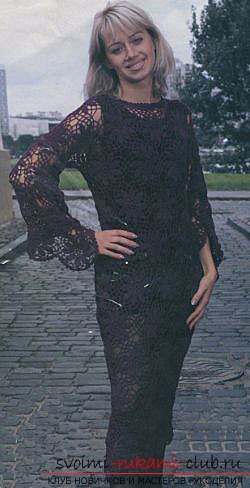 We do the work, weaving out individual floral motifs according to the scheme No. 3.1 and connecting them together in the last row. The density of binding of the main pattern for the motif should be equal in diameter to 12 cm.
We do the work, weaving out individual floral motifs according to the scheme No. 3.1 and connecting them together in the last row. The density of binding of the main pattern for the motif should be equal in diameter to 12 cm. 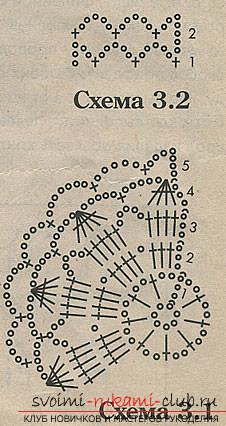 We knit immediately the front and back of the dress,starting from the bottom upward. The method of connecting the flower motifs is shown in the scheme A. The initial row is tying 8 rapports connected at the sides. In the subsequent series, all rapports are connected with the rapport of the previous series and among themselves in this row. Flower motifs are located in a chess-like arrangement, in intervals between the patterns of the preceding series. In this way we knit eight rows.
We knit immediately the front and back of the dress,starting from the bottom upward. The method of connecting the flower motifs is shown in the scheme A. The initial row is tying 8 rapports connected at the sides. In the subsequent series, all rapports are connected with the rapport of the previous series and among themselves in this row. Flower motifs are located in a chess-like arrangement, in intervals between the patterns of the preceding series. In this way we knit eight rows. 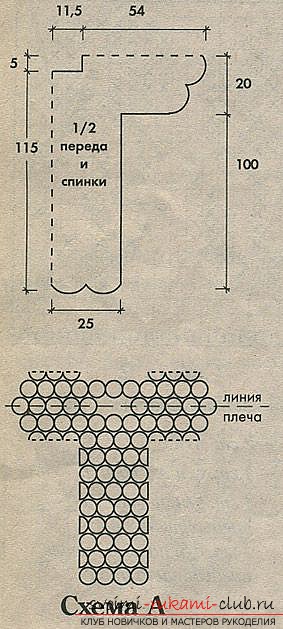 The product is divided into the front and back parts inequal proportions of four rapports and knit separately. To the front of the dress, we add three rapports to the left and right on the sleeves. In Scheme A they are shown in the form of halves and are attached to the front part with only 2 arcs.
The product is divided into the front and back parts inequal proportions of four rapports and knit separately. To the front of the dress, we add three rapports to the left and right on the sleeves. In Scheme A they are shown in the form of halves and are attached to the front part with only 2 arcs.  The following series are knit from ten motifs, and inIn the tenth row, we place eleven rapports in a staggered arrangement. Because of this, the sleeve will lengthen and form an openwork edge. In the eleventh row, we begin to form a notch of the neck, while at the edge of the sleeve the pattern in the chess-shaped arrangement shifts to the edge of the elongation of the sleeve, we knit five rapports on both sides of the neck. Then we knit the final row of the back of the dress from 11 motifs in the same way as the 10th row of the front part of the dress, in parallel in the final row of rapport we combine new floral motifs with the neighboring and with the previously deposed four motifs of the back part and with the three original rapports of the sleeve. We're putting together a dress. On the rim of the neck in the intervals between the rapports fill with a grid of three rows, as shown in figure 3.2. Then we knit on a circle of a mouth three lines under the scheme 3.2. Only in the fourth row, instead of five air loops, we tie three, and the fifth and sixth rows are knitted with columns without a crochet. The seventh row we tie three columns without a crochet, the element "pico", alternating. Bottom of the sleeves, a figured section and the bottom of the dress are tied with two rows of loops without a crochet, and the third row we knit three bars without the crochet and the "pico" element.
The following series are knit from ten motifs, and inIn the tenth row, we place eleven rapports in a staggered arrangement. Because of this, the sleeve will lengthen and form an openwork edge. In the eleventh row, we begin to form a notch of the neck, while at the edge of the sleeve the pattern in the chess-shaped arrangement shifts to the edge of the elongation of the sleeve, we knit five rapports on both sides of the neck. Then we knit the final row of the back of the dress from 11 motifs in the same way as the 10th row of the front part of the dress, in parallel in the final row of rapport we combine new floral motifs with the neighboring and with the previously deposed four motifs of the back part and with the three original rapports of the sleeve. We're putting together a dress. On the rim of the neck in the intervals between the rapports fill with a grid of three rows, as shown in figure 3.2. Then we knit on a circle of a mouth three lines under the scheme 3.2. Only in the fourth row, instead of five air loops, we tie three, and the fifth and sixth rows are knitted with columns without a crochet. The seventh row we tie three columns without a crochet, the element "pico", alternating. Bottom of the sleeves, a figured section and the bottom of the dress are tied with two rows of loops without a crochet, and the third row we knit three bars without the crochet and the "pico" element.


